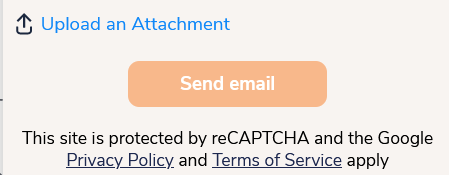If you're using Contextual Help Widget (2.0) on a publicly-available site, we recommend adding spam protection to your contact form and contextual help widget.
You'll need to follow these steps if all the following conditions apply:
- You've enabled the Contact Form in your knowledge base.
- You've embedded the Contextual Help Widget (2.0) in a public website or application.
- You want to protect the Contextual Help Widget's Contact tab with spam protection.
Find your setup in the table below, then select the link to jump to relevant instructions.
| Contact Form spam protection enabled? | Knowledge base domain | Spam protection setting | Link to instructions | reCAPTCHA Key/Secret V3 status | Widget end-user experience | Contact tab spam protection |
|---|---|---|---|---|---|---|
| No | KO subdomain or private domain | Any | N/A | Not required | No different; tab submits | None |
| Yes | KO subdomain | Honeypot | KO subdomains | N/A | No different; tab submits unless end-user violates honeypot restrictions | Honeypot |
| Yes | Private domain | Honeypot | Private domains and honeypot | N/A | No different; tab submits unless end-user violates honeypot restrictions | Honeypot |
| Yes | KO subdomain | Google reCAPTCHA | KO subdomains | Not required; automatically applied | Contact tab displays reCAPTCHA footer statement; tab submits | Google reCAPTCHA |
| Yes | Private domain | Google reCAPTCHA | Private domains and reCAPTCHA | Valid key/secret required | Contact tab displays reCAPTCHA footer statement; tab submits | Google reCAPTCHA |
| Yes | Private domain | Google reCAPTCHA | Haven't added V3 yet | Key/secret required but not yet added | No different; tab submits | None |
| Yes | Private domain | Google reCAPTCHA | V3 added but receiving error | Key/secret required but invalid | Contact tab displays reCAPTCHA statement; reCAPTCHA error thrown when reader tries to submit | Yes, but submissions are prevented |
How it works
The Contextual Help Widget's Contact tab is aware of the spam protection setting in Customize > Contact form and will use your Default method set in Security and access > Spam protection, just as it's used in the Contact form.
For spam protection, you can choose between Google reCAPTCHA and KnowledgeOwl's homegrown honeypot solution. Refer to Spam protection for more information.
If your knowledge base uses honeypot spam protection, no change to the widget display or behavior is visible to your end-users.
If your knowledge base uses Google reCAPTCHA spam protection, the Widget Contact tab uses reCAPTCHA V3, which is a silent/invisible reCAPTCHA--no boxes to check or fire hydrants to find. reCAPTCHA calculates a score behind-the-scenes to determine if your reader is a bot or a human. Widget readers who fail the invisible V3 will not be able to submit the Contact tab. The Contact tab also displays a required statement just below the Submit button:
 Sample reCAPTCHA statement
Sample reCAPTCHA statement
This statement is part of Google reCAPTCHA's terms of service. You can't edit or remove it as long as you're using reCAPTCHA to protect your widget.
KnowledgeOwl subdomains
As with all spam protection settings, if you're using a KnowledgeOwl subdomain (like mykb.knowledgeowl.com), we handle the spam protection maintenance for you.
You'll need to change one setting to protect your widget with honeypot or Google reCAPTCHA spam protection:
- Go to Customize > Contact form.
- Check the Admin Settings box to Use spam protection on ticket submissions.
- Be sure to Save your changes.
We'll apply your knowledge base's default Spam protection method to the contextual help widget.
If your default spam protection method is set to Google reCAPTCHA, the widget's Contact tab displays a required Google reCAPTCHA statement.
If your default spam protection method is set to honeypot, no visible message or alert displays in the widget's Contact tab.
Private domains and honeypot
If you're using your own domain (like help.owlsareawesome.com) and your Security and access > Spam protection > Default method is set to Honeypot, you'll need to change one setting to protect your widget with honeypot:
- Go to Customize > Contact form.
- Check the Admin Settings box to Use spam protection on ticket submissions.
- Be sure to Save your changes.
Private domains and Google reCAPTCHA
If you're using your own domain (like help.owlsareawesome.com) and your Security and access > Spam protection > Default method is set to Google reCAPTCHA, you must add your own V3 reCAPTCHA key and secret to protect your widget's Contact tab:
- Go to Customize > Contact form.
- Check the Admin Settings box to Use spam protection on ticket submissions.
- Be sure to Save your changes.
- Now go to Security and access > Spam protection.
- In the Custom Google reCAPTCHA integration section, add a reCAPTCHA Key V3 and reCAPTCHA Secret V3. Refer to the more detailed instructions in Add reCAPTCHA.
Once you've added your V3 key, the widget displays a required Google reCAPTCHA message near the footer:
This site is protected by reCAPTCHA and the Google Privacy Policy and Terms of Service apply.
Contact Form has spam protection but I haven't added my V3 reCAPTCHA key yet
If you haven't yet entered a V3 reCAPTCHA key, don't worry! Your widget Contact tab will still work. In this state, you won't see the reCAPTCHA statement in the footer and you'll have no reCAPTCHA protections. But the widget can still accept Contact form submissions.
Follow the instructions in Private domains and Google reCAPTCHA above to set up your key.
I have a V3 reCAPTCHA key but my widget displays a reCAPTCHA error
If you enter an invalid V3 reCAPTCHA key/secret, when a reader selects Submit in the Contact tab, they'll receive an error instead of the confirmation message that their request was submitted. The text reads something like: "reCAPTCHA error, could not submit request". Here's a sample of what it looks like to a reader:

To resolve this issue, re-enter your reCAPTCHA V3 Key and Secret and be sure you enter the correct values in the correct fields.

